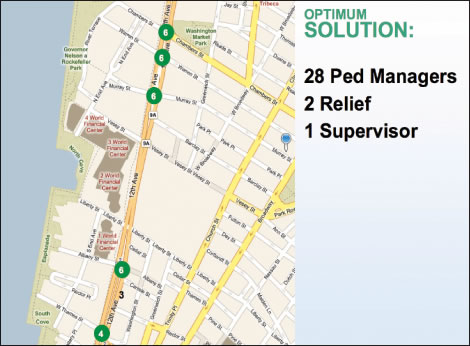By Julie Shapiro
A new bridge, traffic changes and crossing guards for people of all ages might all be on the way to improve safety on West St.
Assembly Speaker Sheldon Silver pressed state and city agencies to commit to those safety changes at a West St. stakeholders meeting last Friday. Local residents have long complained that crossing the highway south of Chambers St. is dangerous, because of short signal times and frequently shifting traffic patterns. Last year, a 26-year-old woman was killed crossing West St. at Albany St.
Silver said last week that it is especially important to make the safety improvements before P.S./I.S. 276, the new K-8 school, opens in southern Battery Park City this fall.
“It is critical to the school and critical generally,” Silver said.
In particular, Silver is pushing city and state agencies to find a way to build a new $21 million bridge over West St. at W. Thames St., to replace the temporary one at Rector St. The Battery Park City Authority had planned to fund the bridge and hired SHoP Architects to design it. But the city, which has jurisdiction over major Battery Park City expenditures, nixed the proposal last year because it was too costly in tight budget times.
After Silver urged all the parties to put the bridge back on the table, the B.P.C. Authority decided to shift $7 million of the $15 million that was supposed to go toward repairing the neighborhood’s seawall to building the bridge instead. Then, the authority would only need the city to approve a $14 million allocation for the bridge. Silver said he would try to fill any gaps with some state money for the bridge as well.
Cavanaugh said delaying some of the seawall work would not pose any safety risks. The authority is in the process of repairing the thousands of underwater concrete pilings supporting the esplanade, and as long as that happens in the next 10 years, there is no rush, he said.
“It’s something that certainly needs to be done, but if it’s not done tomorrow, it’s not going to be a problem,” Cavanaugh said after Silver’s meeting. “No one is in danger of the esplanade collapsing, but starting in September kids are going to be crossing West St. [to attend P.S./I.S. 276].”
Silver’s second proposal is to put crossing guards at five problem intersections: Chambers, Warren, Murray, Albany and W. Thames Sts. Sam Schwartz Engineering, the traffic consulting firm to the Port Authority, already provides the guards, called pedestrian managers, at some of the heavily traveled Church St. crossings and may provide the managers for West St. as well.
At Silver’s meeting, Rob Phillips, C.O.O. of Sam Schwartz, proposed a total of 28 pedestrian managers, two relievers and one supervisor for West St., working from 7 a.m. to 7 p.m. on weekdays and 9 a.m. to 5 p.m. on weekends. That would cost $2 million a year, and Silver is pushing the Lower Manhattan Development Corp. to pick up the tab for two years, totaling $4 million.
“We’re going to work with the board to identify potential funds,” L.M.D.C. Chairperson Avi Schick told Silver at last week’s meeting. “We understand the importance.”
The N.Y.P.D. already has traffic agents at many intersections on West St., but residents often say that they don’t do enough to help pedestrians cross.
“All they’re worried about is cars,” said Linda Belfer, a Battery Park City resident who uses a wheelchair. “We need to have someone on board who is responsible for pedestrians.”
“It’s dangerous,” agreed Maria Smith, another B.P.C. leader. “We need supplemental expertise.”
N.Y.P.D. Inspector Patrick McCarthy replied that the traffic agents have to focus on the cars, both for their own safety and the safety of pedestrians. He acknowledged that the Sam Schwartz pedestrian managers, who all have law enforcement experience, have been helpful on Church St. and would likely be a good addition to West St.
Phillips said West St. south of Chambers St. saw 170 vehicular accidents in 2009, nearly one every other day, based on data from the First Precinct. Over one third of them, 60, happened at Chambers and West Sts., where Phillips would station six pedestrian managers to help people cross.
McCarthy said accidents are down in 2010, with 33 in the first two months of the year compared to 40 in the same period last year.
The State Dept. of Transportation is still reconstructing much of West St. below Chambers and will add some traffic-calming features as the project continues, including colored crosswalks and more than 500 trees in the median, said Joe Brown, the project director.
State D.O.T. is also considering giving pedestrians more time to cross, adding countdown signals and reducing the oft-broken speed limit from 35 miles per hour to 30, Brown said.
Pat Moore, a Cedar St. resident, asked Brown about restoring a left-turn lane from southbound West St. onto Albany St., which would provide key access to the Greenwich St. South neighborhood.
Brown said S.D.O.T. and city agencies are studying the request, but it could cause traffic backups of cars exiting the Brooklyn-Battery Tunnel, especially during the next couple years of construction. West St. will eventually have two left-turn lanes onto Liberty St., but those will not open until World Trade Center construction is much further along.
Silver expects to see more definite plans for the W. Thames St. bridge, the pedestrian managers and the other safety improvements at the next meeting of his taskforce on April 30.
Julie@DowntownExpress.com

































